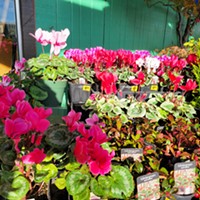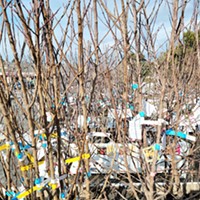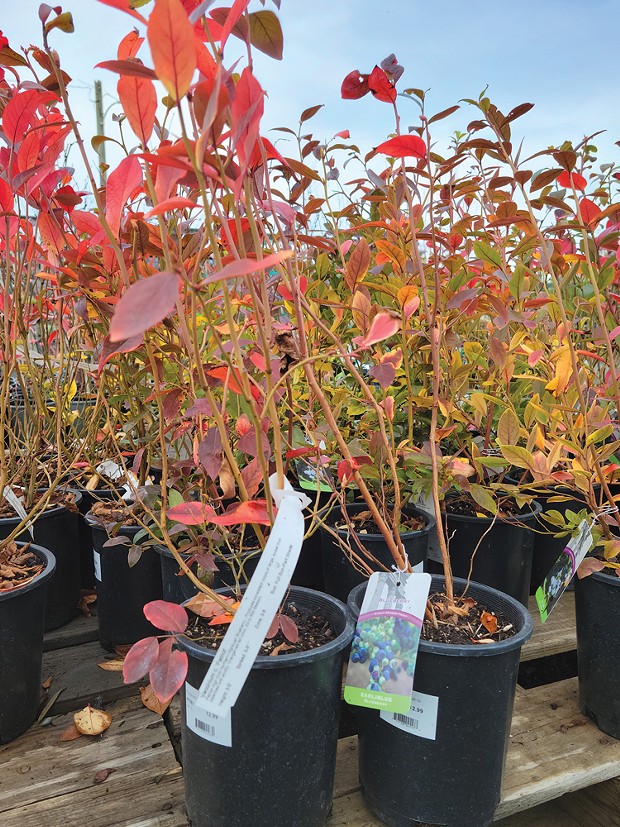[
{
"name": "Top Stories Video Pair",
"insertPoint": "7",
"component": "17087298",
"parentWrapperClass": "fdn-ads-inline-content-block",
"requiredCountToDisplay": "1"
}
]
Now that we're finally receiving some beneficial rain, it's a good time of year to think about some new plants for your garden. Fall is an excellent time to plant shrubs, trees and other plants because the rain will usually provide enough moisture and the temperatures are cooler, both of which allow for strong root growth.
One of my favorite things to plant in the fall are blueberries. Who doesn't love some blueberries fresh from your own yard or balcony on their pancakes, in muffins or over your granola?
I scoped out three of our local nurseries for this article and the selection definitely varies by shop.
There are five types of blueberries available but the ones you'll typically see at local nurseries are: Northern highbush, which can grow to 5 to 9 feet; lowbush, which are usually 1.5 feet or shorter; and half-high, which grow 3 to 4 feet tall. Half-high are frost sensitive but you can find some of the cultivars in our local nurseries. (Patriot is one that I've planted for clients.)
The other two types are Southern highbush, and Rabbit-eye, which also tend to be very frost sensitive, so you won't usually find them here on the North Coast, but you can probably request the nursery order some if that's the kind you're interested in. Highbush are the type most commonly planted in the U.S.
But within the three locally available types of blueberries, there are more than 150 varieties/cultivars from which to choose. Which kind to plant should you buy and how far apart should you plant them?
Do you love sweet berries? Tart? Good for baking or jams? There's a wealth of information online about which ones fit the bill but you can also read the info on the tags at the nursery. Some favorite blueberries I've grown in my garden and planted for clients include: Patriot, Chandler, Bluecrop, Duke, Spartan and Legacy. But read up on your own, as there are many to choose from.
Once you've made your selections, it's time to prepare the planting area. Blueberries do best in full sun and they love our acidic soil. Just the same, I like to toss a little acid fertilizer in the planting hole before putting the plant in. G&B, Dr. Earth and FoxFarm all make excellent organic fertilizers for acid-loving plants, and they're available at our local nurseries.
You can plant a hedgerow of blueberries, in which case you would plant them about 1 to 2 feet apart. Or you can plant them individually, which is usually better for the Northern highbush, since they can get rather large and wide. While most blueberries you can grow here are self-fruitful, it's best to plant more than one variety. In addition, it's helpful to plant varieties that fruit at different times. You'll see the fruiting time listed on the tag: early season, mid-season and late season. Many gardeners offer anecdotal advice about getting better production if you plant at least one of each ripening time. If you do plant them individually, it's better to do so in the same area, rather than scattered all over the place.
Blueberries have a shallow root system and they don't like competition from weeds, nor do they like having wet feet, so make sure to plant them in an area that is well drained. You may need to add some humus (organic matter) to the planting hole to provide better drainage. Dig a hole about 18 inches wide and equally deep if you're planting a one-gallon pot. Important note: If we've had a lot of rain recently, wait a few days for the soil to dry out, otherwise you can compact the soil and smother the roots.
You can amend the soil with some coconut coir instead of peat. Peat used to be the recommended amendment but harvesting from peat bogs has come under scrutiny in recent years as an unsustainable product because it grows back so slowly. Peat holds a lot of moisture and is acidic but so does coco coir, which also has a neutral pH. That's why I like to add some acidic fertilizer. The neutral pH won't hurt the plants.
Remove the plant from the pot and rough up the roots a bit, then plant and backfill with the soil. Mulch them with 2 to 6 inches of an acidic mulch, such as redwood duff or shredded bark, the latter of which is available at local landscape supply companies. Pine needles also work well as an acidic mulch. Just don't put the mulch right up against the plant itself, as that can lead to rot. Think doughnut, not volcano, when it comes to mulching. This goes for trees as well.
Now that you've planted your blueberries, here comes the hard part: Don't let them produce fruit their first year. I know it's painful. But the plant needs to establish its root system and branch growth, rather than produce a small handful of fruit.
Blueberries, especially Northern highbush varieties, need to be pruned every year. Remove any crisscrossing branches to allow light and air circulation into the center of the plant. Also remove any damaged branches or branches that haven't produced any new growth over the past growing season. If you're uncertain as to how to properly prune blueberries, there are plenty of tutorials online or you can ask your local nursery staffer.
Julia Graham-Whitt (she/her) is owner and operator of the landscaping business Two Green Thumbs.
She is thankful for her wife, her critters and being able to live and work in such a beautiful place.
Speaking of...
-

Winter Planting for Future Color
Dec 21, 2023 -

Bare Root Time
Feb 16, 2023 -

Cooperation Humboldt Plants Fruit Trees for Everyone
Mar 31, 2021 - More »
Comments
Showing 1-1 of 1
more from the author
-
Working it Out in the Garden
- Jan 18, 2024
-
Winter Planting for Future Color
- Dec 21, 2023
-
Equinoctial To-Do and Native Plants
- Sep 21, 2023
- More »
































